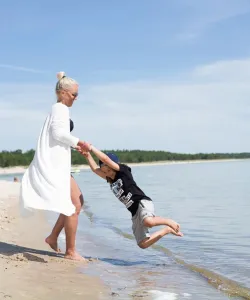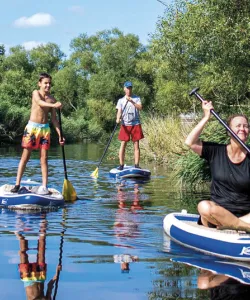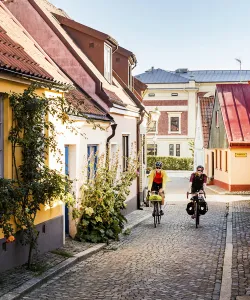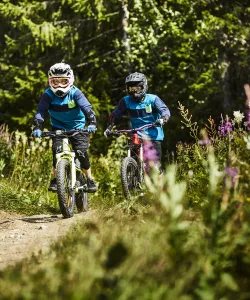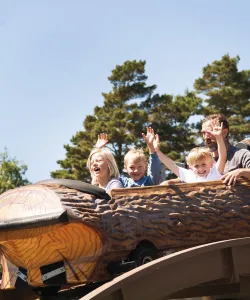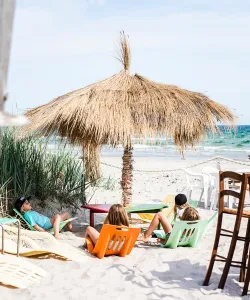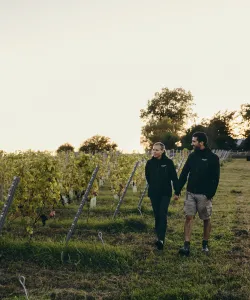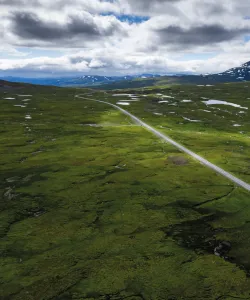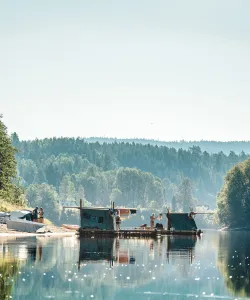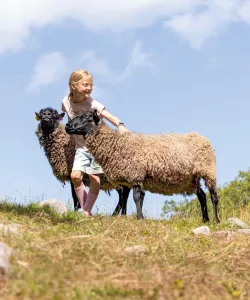
AROUND LAKE VÄNERN
Rolling fields, mystical forests, famous battles and delicious drinks. Sweden's largest lake offers storytelling, culinary experiences and nature.
The view is hard to beat. From Kinnekulle, it spans forests, rolling fields, and small waterways, and at the horizon Lake Vänern sparkles in all its glory. The tableland mountain and the nature reserve west of Götene are a great place to start an article about the area around Lake Vänern. The varied, lush and unique nature created between Sweden's largest lakes, Lake Vänern here and Lake Vättern to the east, thrives on what is often called the "blooming mountain". The amount of plant diversity here is rare in Sweden: wild spring onions discovered first with the nose and then with the eyes, countless late-spring cherry trees, and early purple orchids.
This article, and naturally the trip it describes, could just as easily have started at any number of other places around Lake Vänern and offered a completely different experience, which is the point of coming here. Its variation is its strength. The area covered by Sweden's largest lake is so large that it has almost everything. The fertile Västgöta plains to the south, the locks of Göta Canal to the east, Dalsland's idyllic waterways to the west, and the Värmland forests to the north.
We are starting at Kinnekulle, which makes it easy to continue on to the cosy Västgöta cities and other areas to the east and south-east. A short trip inland, for example, takes visitors to one of Sweden's most dramatic historical events. Hova Medieval Week is held every year in July (this year 9-17/7) to commemorate the faboulus battle fought here in 1275. The intense battle between king Valdemar Birgersson and his brothers Erik and Magnus is one of the most well known to Swedish history. Magnus' hired soldiers from Denmark and Germany defeated Valdemar's force of farmers, and Magnus then claimed the throne and became one of Sweden's most influential and important kings. The town celebrates the battle today by re-enacting the Middle Ages, complete with knights and spectacular tournaments. A must for families with kids.
History and fish on the menu
Mariestad is also rich with history. Visitors can take guided tours of the old town and its characteristic wooden houses, relax in lush Alparken, which dates back to the 1860s, or visit the magnificent late-Gothic cathedral built in 1593. lf there is time for a short detour, Lake Vänern's largest island Torsö has prehistoric markings, hiking trails and the excellent restaurant Laxhall with views of the lake.
lf historical excursions make you hungry, there are plenty of fish restaurants in Mariestad, particularly at the harbour. And if the contents of your glass are just as interesting as what's on your plate, don't miss the beer brewery Bryggeriet Mariestad or the whisky distillery Kingfisher.
Continuing south, the road leads to Lidköping, where visitors can get a closer look at Lake Vänern to contrast the spectacular panora ma view from Kinnekulle. Lake Vänern Museum features an aquarium with fish from the lake and a !arge collection from the long history of shipping and trade in the area. And shipping and trade are still highly relevant: many of the boats headed into Lake Vänern's archipelago leave from Lid köping. There is also shopping: a unique selection of boutiques and the Rörstrandstore from the local porcelain factory.
And when in Lidköping, visitors shouldn't miss the island Kållandsö to the north, which has at least two must-see attractions. Beautiful Läckö Castle, which was built when Sweden was a great power in Europe, offers a kids' safari, lush gardens, and opera as well as guided tours.
North of the castle is also the fishing village Spiken, with its restaurant huts and fish shops, that quite possibly is one of the most idyllic spots around this gigantic lake. Here, at the wharf, visitors will want to do nothing more than order fresh fish and chips and something cold to drink and just enjoy the sun.


Trollywood and impressive locks
Even if Lake Vänern is our main focus, it's hard not to be drawn to the engineering masterpieces that lead to and from the lake. The locks of the Göta Canal in Sjötorp and the canals in Trollhättan are both worth a visit. Trollhättan arranges a festival with live music and a range of activities on the third Friday of July every year to celebrate the brilliant construction of its canals. One event visitor's shouldn't miss is the waterfall: the locks are opened several times a day during the festival, releasing 300,000 litres of water. It's incredible. But this city, which lies below Lake Vänern's most southerly point, has more than just impressive engineering. It's also a mecca for film enthusiasts. Sweden's Hollywood, or Trollywood as it's also called, offers plenty of treasures for those interested in Swedish filmology - and the Danish director Lars von Trier filmed a few of his celebrated works here as well. Many of the city's street corners can be recognized from the bigscreen.
Even Vänersborg, just north of Trollhättan, is a trove of film locations, but the city's nickname "Little Paris" hints that there is more to see here. Poet Birger Sjöberg coined the name, and the similarities to the French metropolis are particularly notable in the heart of the city, which features several impres sive buildings, including Vänersborg Museum.
If you are looking to cool off, Vänersborg also offers some of the best swimming around the lake, with several central beaches including Nordkroken, Skräcklan, and the kid-friendly and more "off" Ursand.
There are also tableland mountains here, but while Lidköping's Kinnekulle is mainly known for its rich flora, these mountains - Halleberg and Hunneberg - are more known for their rich fauna. Älgens Berg, the only ecopark in western Sweden, is called "moose mountain" for a reason.
DALSLAND - a hidden nature gem
From Vänersborg we head north to Dalsland, where the nature is wilder, the forests denser and the waterways more frequent. No inland province in Sweden has more of a presence of water than here. Lake Vänern is part of this, of course, but there are also canals and small lakes throughout the province that together form an intricate water-borne system. Visitors can easily get around with a paddle: since 25 percent of the province is water, canoeing and kayaking area relaxing and enjoyable means of transportation. And perhaps the most spectacular place to paddle is the famous aqueduct Håverud, which was built in the 1860s and takes paddlers and boat owners across rapids and under two bridges.
And when in Dalsland, don't miss the province's only city: Åmål. This former trading hub with roots back to the 1600s almost burned to the ground in 1901, but part of it emerged unscathed and consists today of an impressive collection of well-preserved and beautiful 17th and 18th century buildings. What used to be the marketplace in the olden days is today a leafy park, which is fitting for a city that offers wonderful nature experiences.


Artistic and adventurous vÄRMLAND
Continuing north into Värmland, a boat ride from Säffle to Lurö archipelago is a must. Sweden's largest lake archipelago offers a unique environment with its many small islands and islets and list of activities - hiking, coffee breaks, and refreshing swims.
In an area with one impressive nature experience after the next, Karlstad is basically the only large city around Lake Vänern. It was granted city status in 1584 and has a rich history and lots of culture. For example Karlstad is home to Alster, birthplace of the Swedish poet and writer Gustaf Fröding. Master of watercolour Lars Lerin is a more modern Värmland profile, and his most famous paintings are hanging at Sandgrund, an art gallery in Karlstad.

Pablo Picasso and erected by Norwegian artist Carl Nesjar.
Sandgrund is also close to another of the city's absolute musts - Värmlands Museum. The entire region's eventful and long history iscaptured undler one roof, but there is also an intention to set large global issues against regional and local perspectives. Visitors should definitely come hungry so they have a reason to slip into the excellent museum restaurant Matbruket for lunch.
Kristinehamn at Lake Vänern's north-east corner is also heavily influenced by art. Most famous is of course the Picasso statue in Vålö sound 7 km outside of the town centre, which also offers an odd combination of culture and nature. The grey concrete statue of Picasso's wife Jacqueline is 15 m tall, but it both blends in with and stands out from the cliffs along Lake Vänern's shoreline. Kummelön island is the perfect addition for visitors who want more nature. The combination of mature trees, meadows, archipelago and easily accessible walking trails makes this nature reserve perfect for most visitors, and children in particular.
The peaceful nature feels close here. Like around much of Lake Vänern.
attractions nearby
Accomodation around lake vänern
Selected filters:

